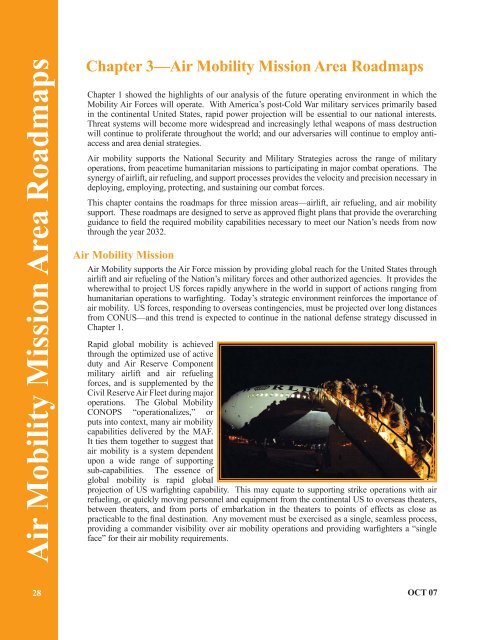Air Mobility Plan, 2008 - The Black Vault
Air Mobility Plan, 2008 - The Black Vault
Air Mobility Plan, 2008 - The Black Vault
You also want an ePaper? Increase the reach of your titles
YUMPU automatically turns print PDFs into web optimized ePapers that Google loves.
<strong>Air</strong> <strong>Mobility</strong> Mission Area Roadmaps<br />
Chapter 3—<strong>Air</strong> <strong>Mobility</strong> Mission Area Roadmaps<br />
Chapter 1 showed the highlights of our analysis of the future operating environment in which the<br />
<strong>Mobility</strong> <strong>Air</strong> Forces will operate. With America’s post-Cold War military services primarily based<br />
in the continental United States, rapid power projection will be essential to our national interests.<br />
Threat systems will become more widespread and increasingly lethal weapons of mass destruction<br />
will continue to proliferate throughout the world; and our adversaries will continue to employ antiaccess<br />
and area denial strategies.<br />
<strong>Air</strong> mobility supports the National Security and Military Strategies across the range of military<br />
operations, from peacetime humanitarian missions to participating in major combat operations. <strong>The</strong><br />
synergy of airlift, air refueling, and support processes provides the velocity and precision necessary in<br />
deploying, employing, protecting, and sustaining our combat forces.<br />
This chapter contains the roadmaps for three mission areas—airlift, air refueling, and air mobility<br />
support. <strong>The</strong>se roadmaps are designed to serve as approved flight plans that provide the overarching<br />
guidance to field the required mobility capabilities necessary to meet our Nation’s needs from now<br />
through the year 2032.<br />
<strong>Air</strong> <strong>Mobility</strong> Mission<br />
<strong>Air</strong> <strong>Mobility</strong> supports the <strong>Air</strong> Force mission by providing global reach for the United States through<br />
airlift and air refueling of the Nation’s military forces and other authorized agencies. It provides the<br />
wherewithal to project US forces rapidly anywhere in the world in support of actions ranging from<br />
humanitarian operations to warfighting. Today’s strategic environment reinforces the importance of<br />
air mobility. US forces, responding to overseas contingencies, must be projected over long distances<br />
from CONUS—and this trend is expected to continue in the national defense strategy discussed in<br />
Chapter 1.<br />
Rapid global mobility is achieved<br />
through the optimized use of active<br />
duty and <strong>Air</strong> Reserve Component<br />
military airlift and air refueling<br />
forces, and is supplemented by the<br />
Civil Reserve <strong>Air</strong> Fleet during major<br />
operations. <strong>The</strong> Global <strong>Mobility</strong><br />
CONOPS “operationalizes,” or<br />
puts into context, many air mobility<br />
capabilities delivered by the MAF.<br />
It ties them together to suggest that<br />
air mobility is a system dependent<br />
upon a wide range of supporting<br />
sub-capabilities. <strong>The</strong> essence of<br />
global mobility is rapid global<br />
projection of US warfighting capability. This may equate to supporting strike operations with air<br />
refueling, or quickly moving personnel and equipment from the continental US to overseas theaters,<br />
between theaters, and from ports of embarkation in the theaters to points of effects as close as<br />
practicable to the final destination. Any movement must be exercised as a single, seamless process,<br />
providing a commander visibility over air mobility operations and providing warfighters a “single<br />
face” for their air mobility requirements.<br />
28<br />
OCT 07
















